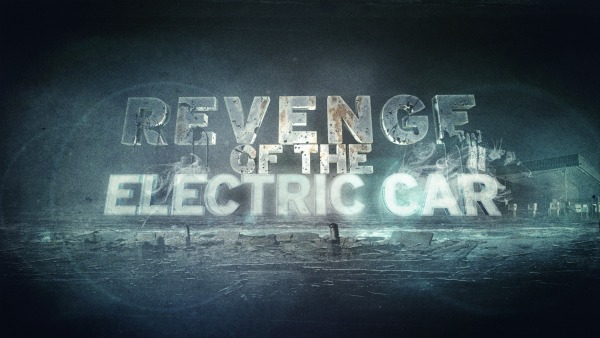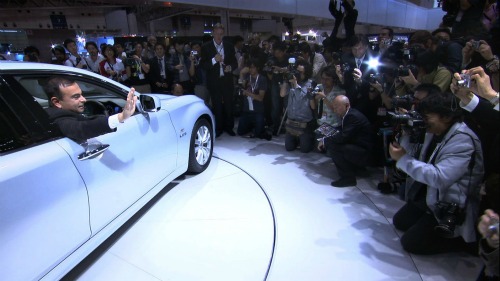 There are a couple of things you ought to know about the new film Revenge of the Electric Car, director Chris Paine’s sequel to his 2006 documentary Who Killed the Electric Car?
There are a couple of things you ought to know about the new film Revenge of the Electric Car, director Chris Paine’s sequel to his 2006 documentary Who Killed the Electric Car?
First, this would be more aptly named The Running Saga of the Electric Car, or better yet, How The Electric Car Gets Its Ass Kicked Over And Over, But Keeps Crawling Back for More.
The second thing you should know is that this is a movie made to appeal to car freaks — read: most Americans — but even if you consider yourself above all that, as you huff and wheeze your petroleum-free ass to work on your bike each day, this is a film worth seeing. (It’s on tour now.)
Paine wants you to know right up front that Revenge is not an assault on life, liberty, or the pursuit of a rubber-burning joyride around town. The film opens with Wall Street Journal auto columnist Dan Neil singing the automobile’s praises: “It has built fortunes. It has saved lives. It has created communities. It’s made untold numbers of businesses possible.”
Neil then takes us for a ride, the cameraman sitting shotgun. “See this car right here? This Porsche Cayman S? This is a stone-cold mother of a car,” Neil says. “Look how cute that car is. Look at that Honda Fit. Yes baby, cute. Awesome car. The problem is the gasoline in the tank.”
Did you catch that? In case you missed it: The problem, as Paine sees it, isn’t our national obsession with getting to wherever we like, whenever we like, without having to be bothered with the unwashed masses. No! We can have our cake and eat it too, if only we can get rid of that blasted gasoline in the tank.
Unconvinced? We’ll get to that in a minute. First, a thumbnail:
 Carlos Ghosn.After a fuel-injected introduction, Paine offers a quick recap of his first film, which centered on the EV-1, a prototype electric car created, then buried, by General Motors. He then turns to the interwoven tales of four men. The first is longtime GM executive Bob Lutz, who saw the company through its Hummer days, then got religion (thanks in part to a brush with bankruptcy) and became a champion of the Chevy Volt. The second story is the tabloid saga of Elon Musk, the wunderkind who created PayPal, made a fortune selling it, and then spent that fortune building, among other things, Tesla Motors, maker of the uber sleek (and ever troubled) Roadster. The third is Carlos Ghosn, CEO of Nissan and the man behind the “zero emissions” Leaf. Last is Greg Abbott, a.k.a Gadget, a tinkerer who appeared in the first film and loves to retrofit classic cars with electric engines.
Carlos Ghosn.After a fuel-injected introduction, Paine offers a quick recap of his first film, which centered on the EV-1, a prototype electric car created, then buried, by General Motors. He then turns to the interwoven tales of four men. The first is longtime GM executive Bob Lutz, who saw the company through its Hummer days, then got religion (thanks in part to a brush with bankruptcy) and became a champion of the Chevy Volt. The second story is the tabloid saga of Elon Musk, the wunderkind who created PayPal, made a fortune selling it, and then spent that fortune building, among other things, Tesla Motors, maker of the uber sleek (and ever troubled) Roadster. The third is Carlos Ghosn, CEO of Nissan and the man behind the “zero emissions” Leaf. Last is Greg Abbott, a.k.a Gadget, a tinkerer who appeared in the first film and loves to retrofit classic cars with electric engines.
If that seems like a lot of cars to pack into one narrow road, it is. Revenge, like many recent documentaries (Urbanized comes to mind), would have benefited from one last pruning. While the tales of these four men are compelling by themselves, combined, they can be something of a CHiPS-style pile-up. (Of course, the music and cinematography have come a long way since 1978.) And while the film does an admirable job charting the road that the electric car has traveled to get from vision to highway, there are so many bumps and curves that the overall arc of the story gets lost. I kept expecting it to end, then it would launch into another chapter, and another.
Spoiler alert: All four men and their electric car projects are brutalized — some more than once — by the economy, misfortune, or poor planning, but the story ends on a triumphant note. As the film winds down, New York Times columnist Thomas Friedman says of the electric car, “It’s the only car in the world that gets cleaner over time. The more you clean up the [electric] grid, the cleaner your car gets.” Revenge closes with actor Danny Devito, the wistful former owner of an EV-1, gleefully test-driving a Volt as the song “Living in a Dream World” plays in the background.
That’s right, folks: The great green future is in sight — and we can drive there!
OK … So, about that notion that the car isn’t the problem — it’s just what’s in the tank. Well, kinda. That gasoline is, obviously, the source of a lot of evil in this world. The trouble is that: 1. In the short-term, the electric grid is a grubby thing, so buy a Volt or a Leaf and you’re essentially trading a gas-powered car for a coal-powered one (burning coal still generates 45 percent of U.S. electricity); and 2. The car is just the tip of the proverbial iceberg.
Take a look at the infrastructure necessary to keep the thing going: We spend $186 billion per year to maintain our ground transportation system, according to energy analyst Chris Nelder. “Gridlock — sitting unproductively in traffic, going nowhere fast — already costs us over $100 billion per year in wasted time,” he adds.
Trading your gas tank for a battery does nothing to change that. Nor does it change the fact that roughly 35,000 people die in traffic accidents each year, or that an estimated 1 to 2 million large animals are hit by cars annually. Driving and car-centric development have also been tied to increased levels of obesity and diabetes, among other things. (Switching to coal power doesn’t get us very far: Grist’s David Roberts reports that coal-generated electricity imposes more in public health costs than the electricity is worth on the market.) And don’t even get me started on all the idiotic suburban development the automobile has enabled — and what we’ve collectively paid for that.
With Revenge of the Electric Car, Paine has made a smart, action-packed, futuristic film. (You can watch a trailer here.) He knows his audience: We Americans love our autos — you’ll pry the car keys from our cold, dead hands. And as much as electric cars are a decent stopgap as we retool our transportation system to provide real, workable alternatives, this film has done its job: helping to convince us that electric power can be just as fun as the fuel-injected kind.
But at this juncture, stopgaps are not going to save us or the planet. We need visionaries who can see past the next automotive gimmickry to a future that has not just horsepower, but staying power, too.



